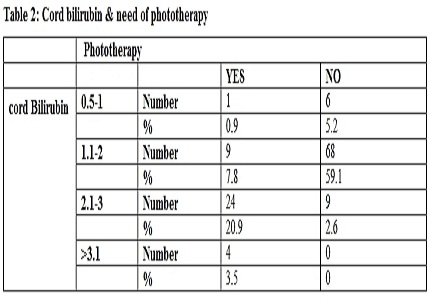Cord bilirubin as a predictor for development of hyperbilirubinemia in term neonates
Abstract
Introduction: Hyperbilirubinemia is a common problem among term newborns. Cord bilirubin level has been found to correlate well with day 3 bilirubin level. We studied whether cord bilirubin could predict risk of development of significant hyperbilirubinemia among term neonates.
Methodology: Prospective study from October 2009 -July 2010. All newborns between 37 weeks -42weeks, birth weight > 2500 gram, Apgar score > 7 at 1st& 5th minute of life were included in the study. Cord blood, day 3 & day 5 bilirubin was collected. Maternal data & bilirubin values were collected & analyzed using SPSS software.
Results: About 115 babies were studied. There was no significant difference in cord bilirubin & day 3 bilirubin between babies born to mothers < 30 years &> 30 years. There was no significant difference in bilirubin values bassed on mode of delivery. About 29.6% babies developed clinical jaundice & received phototherapy. Cord bilirubin levels had significant association with need of phototherapy. Cord bilirubin >/= 2.1 mg/dl predicted need for phototherapy with PPV of 90.3%. Maternal age, sex of baby, birth weight & gestational age had no significant effect on cord bilirubin levels. Cord bilirubin >/= 2.1 mg/dl predicted day 3 serum bilirubin > 15 mg/dl with sensitivity of 88 % & PPV of 77.49 %. The likelihood ratio with cord bilirubin > 2.1 mg/dl & day 3 serum bilirubin > 15 mg/dl was 9.316.
Conclusion: Cord bilirubin is predictive of need of phototherapy & correlated well with day 3 bilirubin levels which would facilitate early management of neonatal hyperbilirubinemia.
Downloads
References
2. Alpay F, Sarici SU, Tosuncuk HD, Serdar MA, Inanç N, Gökçay E.The value of first-day bilirubin measurement in predicting the development of significant hyperbilirubinemia in healthy term newborns.Pediatrics. 2000 Aug;106(2):E16.
3. Cohen RS, Wong RJ, Stevenson DK. Understanding neonatal jaundice: a perspective on causation. Pediatr Neonatol. 2010 Jun;51(3):143-8. doi: 10.1016/S1875-9572(10)60027-7.
4. Soskolne El, Schumacher R, Fyock C, et al. The effect of early discharge and other factors on readmission rates of newborns. Arch Pediatr Adolesc Med 1996:150:373-379. [PubMed]
5. Sarici SU, Yurdakök M, Serdar MA, Oran O, Erdem G, Tekinalp G, YiğitS. An early (sixth hour) serum bilirubin measurement is useful in predicting the development of significant hyperbilirubinemia and severe ABO hemolytic in a selective high risk population of newborns with ABO incompatibility. Pediatrics. 2002 Apr;109(4):e53.
6. Knudsen A, Lebech M. Maternal bilirubin, cord bilirubin and placental function at delivery in the development of jaundice in mature newborns. Acta Obstet Gynecol Scand 1989 (Jan) ; 68:719-724.DOI: 10.3109/00016348909006145. [PubMed]
7. Yamuchi et al. Difference in TCB readings between full term newborn infants regionally of caeserean section. Actascand. 1998 Nov; 78(6): 824-8. [PubMed]
8. Ip S, Chung M, Kulig J, O'Brien R, Sege R, Glicken S, Maisels MJ, Lau J. An evidence-based review of important issues concerning neonatal hyperbilirubinemia. Pediatrics 2004; July 114(1)263-264.
9. Maisels MJ, Kring EA. Length of stay, jaundice and hospital readmission.Pediatrics. 1998 Jun;101(6):995-8. [PubMed]
10. Frishberg Y, Zelikovic I, Merlob P, et al. Hyperbilirubinemia and influencing factors in term infants. Isr J Med Sci 1989;25:28-31. [PubMed]
11. Risemberg HM, Mazzi E, MacDonald MG, Peralta M, Heldrich F.Correlation and Cord bilirubin levels with Hyperbilirubinemia in ABO incompatibility. Arch Dis Child. 1977 Mar;52(3):219-22. [PubMed]
12. Rosenfeld J. Umblical cord as a Predictor of subsequent of hyperbilirubinemia. J Fam Pract. 1986 Dec;23(6):556-8. [PubMed]
13. Mathias knofer, Ferdinand Pulsar, Corrina Predictive value of cord bilirubin for post natal hyperbilirubinemia. Acta paediatrica,vol 94,2005,581-587. [PubMed]
14. Srivastava N et al. A study of serum bilirubin in neonates in relation to maternal age.Indian J Med Sai. 1999 Apr; 53(4) ; 154-6.

Copyright (c) 2016 Author (s). Published by Siddharth Health Research and Social Welfare Society

This work is licensed under a Creative Commons Attribution 4.0 International License.


 OAI - Open Archives Initiative
OAI - Open Archives Initiative


